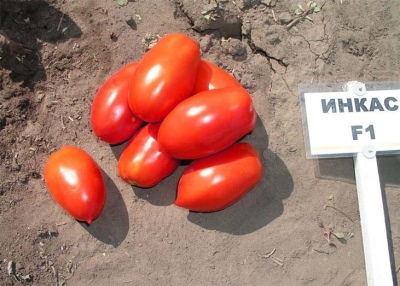
- Authors: Nunhems B.V.
- Year of approval: 2000
- Category: hybrid
- Growth type: determinant
- Appointment: universal
- Ripening period: mid-early
- Ripening time, days: 95-100
- Growing conditions: for open ground, for film greenhouses
- Transportability: high
- Bush size: medium-sized
Experienced gardeners and farmers who grow tomatoes on an industrial scale prefer proven and fruitful varieties. These include the Dutch type of tomato Inkas, which grows well both in garden beds and in greenhouse conditions.
Breeding history
The mid-early tomato variety was bred by a group of Dutch breeders representing the seed company Nunhems B. V. in 1999. A year later (in 2000) the nightshade crop was included in the State Register and approved for use. The task of the scientists was to create a fruitful and unpretentious species that grows well in open ground and film greenhouses in different climatic zones.
Description of the variety
The hybrid vegetable culture Inkas is a medium-sized shrub of the determinant type, growing up to 100 cm in height. The compact plant is endowed with powerful stems, a developed root system and a moderate thickening of dark green foliage. During the season, up to 6 brushes are formed on each stem, where 8-10 fruits (ovaries) are formed. The bush requires the formation of 2-3 stems, a garter to the supports, as well as regular pinching, since new stepchildren appear quite quickly.
The main qualities of the fruit
The Inkas tomato has a regular plum-like (cuboid) shape and a uniform red color. Unripe tomato is light green in color. The skin of the fruit is smooth and firm, with a pronounced gloss. It is the strength of the peel that protects the berries from cracking, and also ensures good transportation and safety of the fruits. The average weight of a tomato is 80-100 grams. It is characteristic that all tomatoes grow perfectly the same in shape and size.
Taste characteristics
The tomato has a pleasant aroma and sweetish taste. Against the background of moderate sweetness, a slight sourness is barely caught. The flesh of the fruit is dense, fleshy, sugary, with a small amount of seed. If the tomato is cut, then the juice is almost not released. The variety belongs to universal, therefore it is suitable for fresh consumption, canned, dried. Inkas is especially good for whole-fruit canning.
Ripening and fruiting
The Dutch tomato belongs to the class of mid-early hybrids. From the moment of seed growth to harvest, it takes 95-100 days. The fruiting period is somewhat delayed - it lasts about 45-60 days, but a large proportion of the crop can be harvested in the first month. Ripening of berries occurs evenly, so you can harvest with whole brushes.
Yield
The yield of the hybrid is high and stable. Subject to all the rules of agricultural technology, you can collect up to 4.7 kg of fruits from 1 m2. Yield indicators in the garden and in the greenhouse may differ slightly. Experienced gardeners collect up to 3 kg of tomatoes per season from one healthy bush. Yield indicators directly depend on the timely removal of stepchildren.
The timing of planting seedlings and planting in the ground
The seed is planted 55-60 days before the expected date of planting the bushes in the garden or greenhouse. The optimal period for sowing seeds for seedlings is March. Seeds are planted in nutritious and loose soil. The seed does not require pretreatment and soaking. Diving (seating) is carried out at the stage of appearance of 2-3 true leaves.
The room for growing seedlings should be well lit and warm. The greenhouse effect (covering with glass or polyethylene) will help accelerate the appearance of sprouts. Disembarkation in the garden is carried out at the end of May, and in the greenhouse at the beginning of the month.

Growing tomato seedlings is an extremely important process, because it largely depends on whether the gardener will be able to harvest at all. All aspects must be taken into account, from seedbed preparation to planting in the ground.
Landing scheme
It is recommended to plant no more than 3 seedling bushes per 1 m2. A 40x50 cm scheme is considered ideal for planting a plant.

Growing and care
It is recommended to grow tomatoes in an area well-lit by the sun. The soil should be free of weeds, breathable, moderately moist. Comprehensive crop care includes a number of standard activities: watering, forming a bush, removing stepchildren, garter, feeding, pest control.




A plant needs different micronutrients at each stage of growth. All fertilizers can be divided into two groups: mineral and organic. Folk remedies are often used: iodine, yeast, bird droppings, eggshells.
It is important to observe the rate and period of feeding. This also applies to folk remedies and organic fertilizers.
Disease and pest resistance
The plant's increased immunity provides protection against verticillosis and fusarium wilting.


Resistant to adverse weather conditions
The hybrid culture is resistant to direct exposure to sunlight and adverse weather factors - drought, sharp drops in temperature. The only natural factor negative for the plant is prolonged humidity, which causes phytophthora.
Growing regions
The nightshade crop is massively grown throughout the territory of the Russian Federation, in certain regions of Ukraine and Moldova.
Review overview
This hybrid variety has been popular with summer residents and farmers for many years, since it is characterized by rapid adaptation to the soil and climate of the growing zone, is completely unpretentious in maintenance, gives stable yields, and can also be stored and matured for a long time at room temperature.

























































































